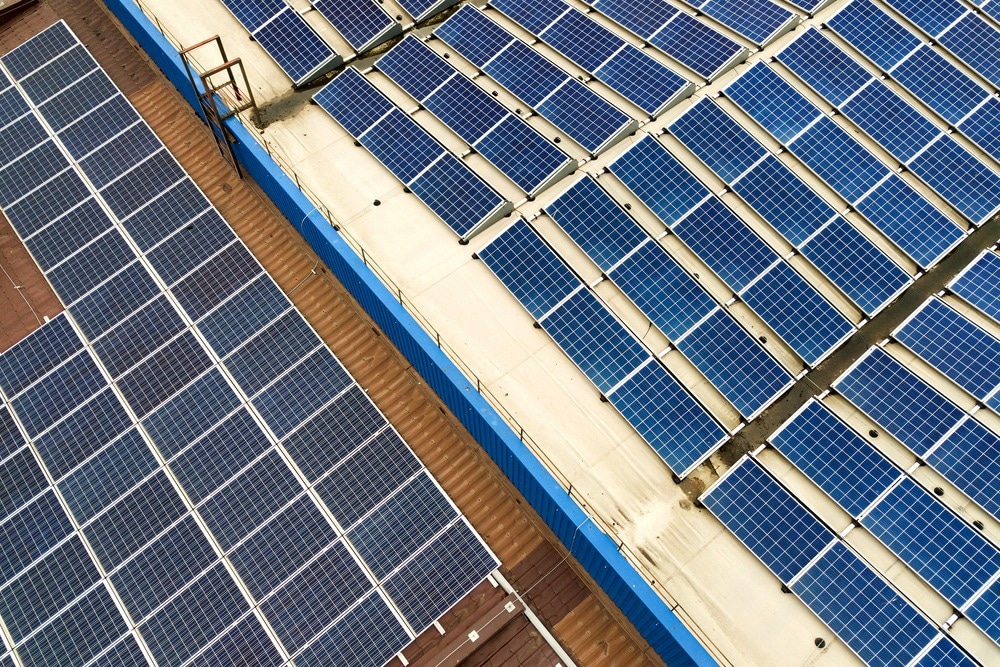In a paper recently published in the journal ACS Energy Letters, researchers demonstrated that trapping ions at the transport layer interface of perovskite and electrons causes band bending, which increases the device's open-circuit voltage (Voc) and built-in potential.

Study: Persistent Ion Accumulation at Interfaces Improves the Performance of Perovskite Solar Cells. Image Credit: Bilanol/Shutterstock.com
Background
Recently, lead halide perovskites have received significant interest because of their outstanding performance in solar cells, with power conversion efficiencies equivalent to inorganic silicon equipment. Furthermore, the simplicity of production and fairly low processing temperature make perovskite photovoltaics particularly appealing for future applications such as smart windows and building integration. However, some challenges in these applications exist, such as stability, scalability, and sustainability. However, perovskite solar cells rarely exhibit long-term instability.
The phenomena of light-soaking are usually attributed to the volatility of the device's properties. The potential involvement of ion-redistribution in improving the perovskite solar cells' photovoltaic performance contrasts sharply with the typically unfavorable perception of ion migration within perovskite photovoltaics. The establishment of ion migration as one of the primary internal causes accountable for the deterioration of perovskite photovoltaics has resulted in significant attempts to develop mitigating measures.
About the Study
In this study, the team showed that the thermal equilibrium drove interfacial ion migration and accumulation, resulting in permanent interfacial ion trapping at the perovskite/extraction layers. This type of ion trapping causes band bending along the interface of the extraction layers, which was investigated experimentally using a unique depth profiling approach based on ultraviolet photoelectron spectroscopy (UPS).
Density functional theory (DFT) computations supported the experimental findings. As electron and hole extraction layers, the device structure explored in this study employed phenyl-C61 butyric acid methyl ester (PCBM) and poly(3,4 ethylenedioxythiophene) polystyrenesulfonate (PEDOT:PSS), respectively. The device was subjected to both light and electrical bias in a dual-scan current-density-voltage (J-V) evaluation. To determine whether the internal field caused a similar increase in the Voc, the performance of pre-biased and unbiased devices was monitored immediately after synthesis and during storage under inert dark environments for one or three days.
Furthermore, gas cluster ion beam (GCIB) etching on whole perovskite photovoltaic devices was applied to directly investigate the variations in the energetics of pre-biased and newly fabricated photovoltaic devices. The interface between the perovskite active layer and the electron transport layer (PCBM) was emphasized, while the valence band structure was determined by UPS. The UPS depth profile data were analyzed by fitting it to methylammonium lead triiodide (MAPbI3) and PCBM reference spectra. Additionally, a device simulation was used to determine the energy band diagram to account for iodide mobility in the perovskite layer while assuming that the ions had not pierced the blocking layers.
Observations
DFT calculations demonstrated that the interstitial iodine was stabilized relative to the bulk at the PCBM interface, generating a considerable driving force directed at the interface. Pre-illumination causes an increase in the device's Voc during the initial measurement, followed by measurements yielding levels identical to the reference device. However, biasing the device in the dark resulted in a Voc augmentation that was somewhat higher than that induced by illumination.
Following measurements under light, samples showed no additional improvement in their Voc, indicating that biasing is the primary parameter with regards to its effect on the Voc. The experiment revealed that the I/Pb ratio in pre-biased devices increased significantly, nearing >3.5 at the PCBM interface. Moreover, with rising storage time, the solar cells' initial performance grew substantially, while the impact of pre-biasing became further irrelevant.
Monitoring the increasing Voc seen in solar cells produced from various precursor stoichiometries gave a clear indication that high iodine ion density samples at the surface exhibited almost no change in Voc following biasing. These findings determined that the improvement in Voc was primarily tied to the device's ionic landscape.
XPS studies on etched perovskite samples showed that the moderate cluster etching utilized in these studies produced no new species. The atomistic structure of a standard, pure slab model derived following thorough DFT relaxation of the atomic sites demonstrated moderate rearrangement near the surface, which was consistent with previous studies. Furthermore, the electronic density-of-states (LDOS) of the associated layered-resolved PBE exhibited conduction bands and flat valence along the slab thickness. These findings were consistent with the general belief that interstitial defects have greater thermodynamical stability near the surface than in the bulk.
Conclusions
To summarize, the researchers demonstrated that ion trapping in perovskite solar cells could improve their photovoltaic efficiency. The rise in Voc was documented for highly optimized solar cells with passivated surfaces as well as for various device structures and compositions, implying that ion-redistribution has a role in enhancing device performance even in cutting-edge devices.
More from AZoM: What are Biopolymer-Based Hydrogel Electrolytes?
Disclaimer: The views expressed here are those of the author expressed in their private capacity and do not necessarily represent the views of AZoM.com Limited T/A AZoNetwork the owner and operator of this website. This disclaimer forms part of the Terms and conditions of use of this website.
Source:
Kress, Joshua A., et al., Persistent Ion Accumulation at Interfaces Improves the Performance of Perovskite Solar Cells, ACS Energy Letters, 2022, 7, XXX, 3302-3310 DOI: https://pubs.acs.org/doi/10.1021/acsenergylett.2c01636